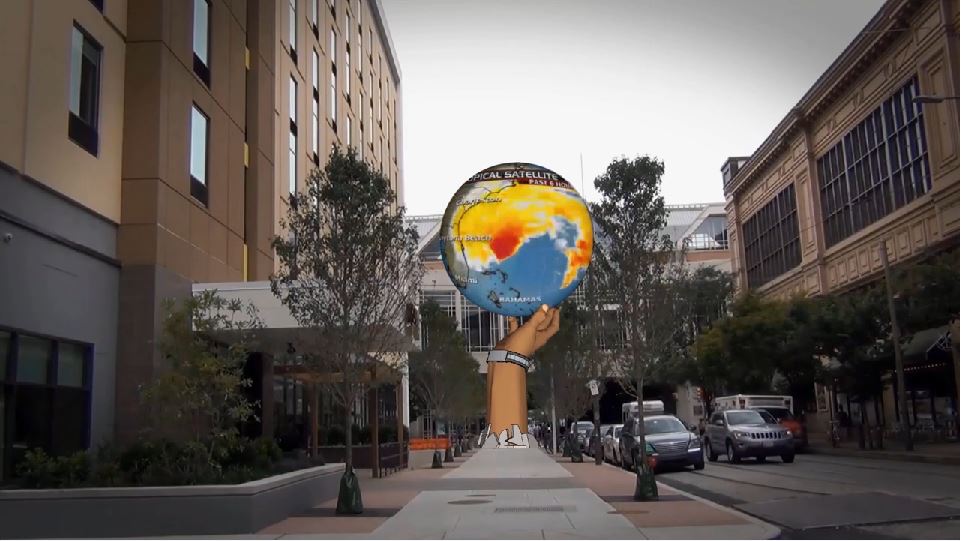Committee approves bill allowing 3-D digital ads in Center City

A giant synthetic forearm burst through the streetscape, lifting a digital-advertising sphere into the sky above the Reading Terminal Market. Seven members of City Council saw it and said, “Yes. Absolutely.”
On Tuesday, Council’s Committee on Rules unanimously approved a bill that would allow a handful of “Urban Experiential Displays”—three-dimensional digital displays that will carry advertisements, original content, and city messages—to be built at a few key corners in Center City.
The bill was introduced last year by Councilman Mark Squilla. It creates a special zoning overlay where the signs will be allowed, though each individual sign will be subject to review from the Planning Commission, the Art Commission, and the Civic Design Review Committee.
Last week, the Planning Commission voted 6-2 against the measure. It had originally reviewed the proposal in January, during an information-only presentation. At that meeting, Commissioners raised questions about the size, height, brightness, and financial components of the legislation; the proposal would have diverted $5.2 million in advertising revenue from each sign to a few local nonprofit groups. After that meeting, Planning staff worked with Councilman Squilla’s office to refine the proposal.
After a series of proposed amendments, a majority of the Commissioners still voted against the bill. That seemed to confound and frustrate members of Council. Committee members Cindy Bass, Wilson Goode, Jr., and Bill Greenlee asked why Planning would go through the trouble of working to amend the bill if they were going to vote against it anyway. Hadn’t the amendments addressed their concerns?
Gary Jastrzab, executive director of the Planning Commission, said that even after the amendments—which limit brightness and require PennDOT approval of each sign—Commissioners still felt the signs were overly big and tall, and would have a negative impact on the public realm.
“If they had a fundamental [opposition],” said Councilman Greenlee after the hearing, “I think they should have just said that, instead of having people, including their own staff, go through all this work and seem to, from what we heard today, address just about every specific concern that was raised, yet then said, ‘We don’t like it.’ Well, maybe they should have just said that.”
Jastrzab said the staff did its best to make the bill palatable to the Commission after the January meeting.
“The Commission expressed some reservations and serious concerns,” Jastrzab said. “ … We tried to work through the process and thought we had at the end a bill that we could pretty much agree on. The Commission still thought its concerns hadn’t been addressed.”
But wasn’t the Planning Commission’s objection more fundamental, more than a desire to see some details rearranged?
“I think it was,” Jastrzab said. “… I think they thought, much too large, much too bright, probably not appropriate at that size for Philadelphia’s kind of fine urban fabric. And we did what we could … We did the best we could do legislatively.”
During the Tuesday hearing, Thaddeus Bartkowski of Catalyst Outdoor presented a video showing renderings of the signs to the committee. In one of the renderings, an image of Council President Darrell Clarke was projected on a sign above the Bellevue garage on South Broad Street. Councilman Greenlee asked, jokingly, whether that was intended to win the committee over.
Bartkowski said it was meant to reflect how “intensely involved” Clarke was in discussions about the proposal. PlanPhilly asked Clarke’s office about its involvement after the hearing.
“The Council President’s office did not work on [this bill],” said Jane Roh, a spokeswoman for Clarke. “There are no plans at this time to introduce a similar measure that would impact the 5th District.”
Representatives of the Reading Terminal Market, the Pennsylvania Convention Center, and the Avenue of the Arts—three groups that stood to benefit, under the original proposal, from the placement of the first UEDs—testified in favor of the bill on Tuesday. John McNichol of the Convention Center said that placing a sign outside his building would actually save taxpayers money, since the Convention Center would otherwise be pursuing installing its own digital signage.
The amended version of the bill would send funds to a “governmental entity” to invest in public improvements. Other amendments prevent the signs from shining much brighter than the ambient light of the day and require the inclusion of local architects and artists in the design of the installations.
Those amendments weren’t satisfying to some witnesses.
Jeff Braff, the president of the Center City Residents Association, said that Catalyst had given a presentation of the UED proposal to the CCRA board. He appreciated the outreach, and admitted that the signs “could be kind of cool,” but said that the CCRA board had nevertheless voted unanimously to oppose the bill.
Another witness, Michael McGettigan, was more blunt: the signs are “fugly,” he said. He said tourists are attracted to the city because of a bell that doesn’t ring, a boxing statue that doesn’t box, and an art museum that doesn’t light up—“not a couple gimmicks on sticks.”
“If you say yes, think of the other junk that’s coming down the road,” McGettigan told the committee. “… Your time is important. You shouldn’t waste it on this stuff.”
The bill will get a first reading in City Council on Thursday. It could come up for a vote of the full Council as soon as next week.
WHYY is your source for fact-based, in-depth journalism and information. As a nonprofit organization, we rely on financial support from readers like you. Please give today.



